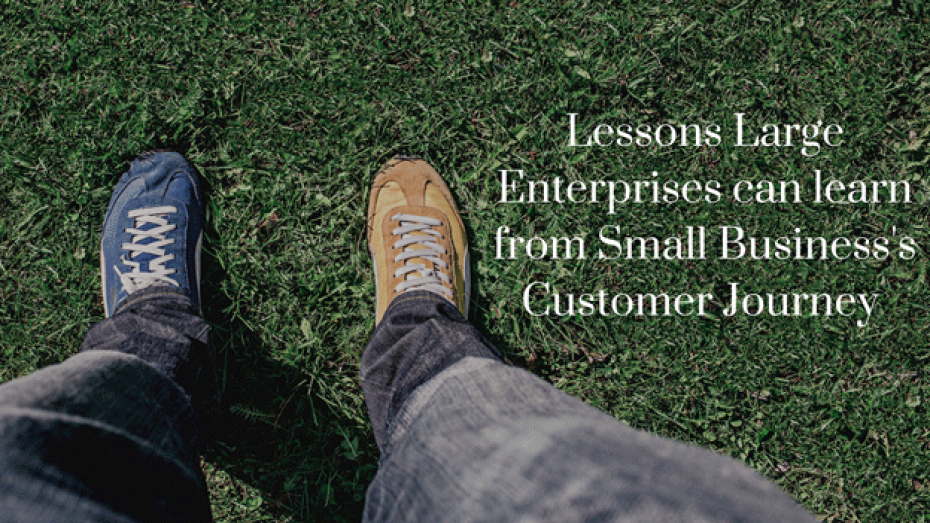Lessons Large Enterprises Can Learn from Small Business’s Customer Journeys

Understanding a Customer’s Journey is pivotal for a business, irrespective of its size, in order to draw insights into customers’ experiences along with the perceptions they draw when interacting with the company.
Small businesses, in particular, are pivotal for learning due to their small size which gives them the agility and flexibility to innovate changes quickly while remaining close to their customers, thus providing value through their products and services.
In this blog, we are highlighting some key aspects of B2B Customer Journey from small businesses that larger businesses may utilize to reflect and adapt for better results.
1. Autonomy and Accountability
Small businesses, especially B2B, do not have the luxury of endless customers. So the efforts are aligned to ensure loyalty through personalized interactions, cross-skilled employees, and empowered resources. They drive customer loyalty by making quick decisions and lowering turnaround time for customer ease. The compact size of small businesses makes their team have autonomy and accountability, as opposed to larger businesses, which thrive on standard processes with multiple checks which lengthen the decision-making process. Large-scale organizations can reassess their processes in order to instill more autonomy, and accountability, thus empowering their employees to deliver exceptional experiences for greater customer loyalty.
2. Customized Deliverables
Small business management has a better view of connecting with customers directly across the stages, which provides the opportunity to manage escalations and better understand customer needs throughout the journey. Customers feel heard and important with direct access to decision-makers. Mostly, this availability is not an advantage with large enterprises. Senior leadership is not involved in daily ground-level issues and strategizing business growth. Such companies run a high risk of missing out on high customer engagement scores. Larger companies can understand customer emotions, pain-points, and expectations at various stages and imply where they need to be more involved and become more actively engaged with clients. Having close proximity to customers supports fine-tuning efforts for more customized deliverables.
3. Patience with the longer and focused journey
Business to business customer journey cycles have long gestation periods and focused deliverables which often mean tighter timelines for delivery. The long gestation period is due to a myriad of reasons including the expectation of customers to be understood and working with them to quantify their requirements. It leads to the need for focused deliverables and timelines. This period calls for patience and maintaining focus while doing due diligence to meet the client’s commitments to their own retail or corporate clients. One important point for larger organizations to incorporate is finding the means of integrating customer point of view at various touch-points and keeping them well-informed on the decisions, deviations, delays etc.
4. Lesser touch-points and reduced complexity
Small businesses can outplay the large businesses due to the flexibility offered by their lean structures. They can innovate quickly, change and adapt the deliverables, and adopt more efficient, innovative practices that support their clients’ needs. Larger organizations can work through lean initiatives to withdraw multiple hand-offs, reduce customer effort and agile processes to encourage creativity, feedback, and elimination of delays.
Business-to-Business customer journeys are usually long, filled with patience, listening, and nudging the client at the right time with the needed information. Small businesses with small and dedicated teams by design have fewer customers and flexibility to support. Their proximity to their customers and small size make them entail good experience management, wherein the journey is carefully crafted. Frictions are identified and smoothed easily. The result is advocacy and loyalty to them amidst competition. Small businesses survive and thrive due to their unique size and way of working, which makes them closer to their customers.
Irrespective of what industry or scale of business one is, the whole mission of understanding a customer journey is to understand customer emotions and to work in a collaborative manner for an engaged and happy customer.
Interested in learning more about how Customer Journey Mapping can help your business? Call us at 1-800-549-7170 or send an email to nitin@goldresearchinc.com
Gold Research is an award-winning Customer Journey Mapping and Research firm with extensive experiences in journey mapping, path-to-purchase research with a special focus in deploying “real-time” and behavioral/neuroscience research formats to gather in-the-moment customer insights.

Awarded by Feedspot
![]()
Contact Us
1-800-549-7170
GoldResearch, Inc.
8000 I.H. 10 West | Suite 600San Antonio, Texas, 78230